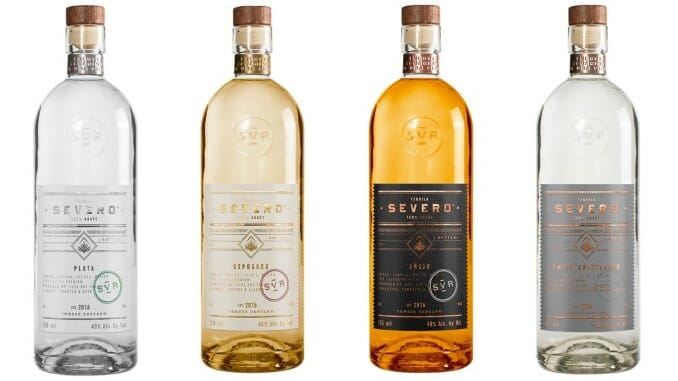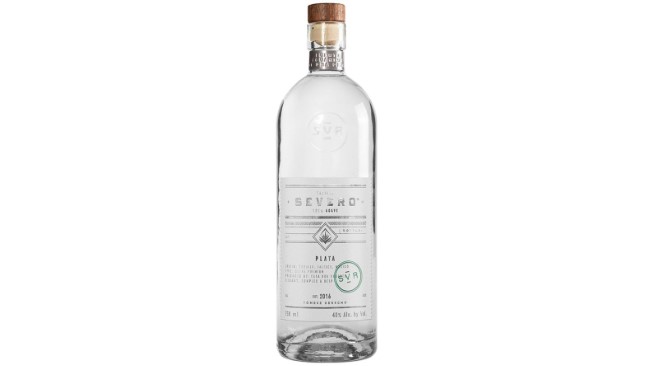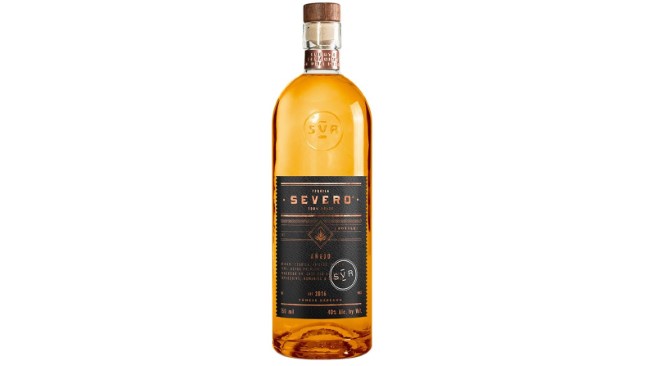Tasting: 4 Tequilas from Severo Tequila
Photos via Hotaling and Co.
The structure and legal definitions that support the tequila industry make for product lineups that are quite easy to understand at a glance, at least once one understands the legal definition of labels such as “reposado” and “anejo.” Unlike, say, the ill-defined world of rum, which is greatly complicated by the fact that regulations and production standards are different in the dozens of countries that produce it, tequila is exclusively a product of Mexico, and one in which labels tend to have concrete and unflinching meanings. If a tequila is labeled as “anejo,” for instance, you know as a consumer that it has most definitely spent at least 1 year aging in oak—never less. This gives the field of tequila a sort of steadiness, although one might also see it as stifling creativity on some level. With that said, however, there are always new avenues to explore, and one of the most popular emerging styles in the last few years is what is referred to as “Cristalino” tequila.
Cristalino is essentially a way of combining the flavors derived from longer oak maturation, which happens in anejo tequilas, with the clear/silver/”white” coloration of unaged tequilas. This is achieved via charcoal filtration, in the same way that many lightly aged rums are stripped of color after several years of aging to make more flavorful “white” rums. You may at this point be asking: Why even bother in the first place? Why does color matter? Well, to the average consumer without a great handle on the science of spirits, color is often of greater importance than it is to true liquor geeks. And when it comes to tequila, clear color is often desired, even among those who don’t realize they appreciate the oak-aged flavor of reposado, anejo or extra anejo. Thus, Cristalino is a way to market aged tequila flavors to people who prefer the look of “premium” unaged tequilas.
The newly launched Severo Tequila brand, from Hotaling & Co., is one such brand that is taking advantage of a new surge of Cristalinos on the market, many of which are marketed as the highest quality and most expensive bottle in their own product lineup—indeed, Severo’s Cristalino costs $10 more than even their anejo. There’s an obvious question to answer here—what, if anything, does the filtration process contribute to the eventual flavor profile? What kind of role could Cristalino tequila play in this segment in the future? Let’s get to tasting the full Severo lineup, and see how it compares. All are produced on column and copper pot stills in Jalisco’s Tequila Valley in Mexico, a major center of tequila production.
Severo Plata TequilaMSRP: $50
Severo Plata, or silver, is a straightforward tequila rested for 6 months in stainless steel, which does seem to mellow it quite a bit, before bottling at the standard 40% ABV (80 proof). This is an impressively flavorful tequila for the low proof point, with punchy and fresh aromatics of raw agave, lime citrus, florals and a little something like white chocolate.
On the palate, Severo Plata is likewise quite vibrant for the low proof—very salty and slightly savory, with gentle sweetness and noticeably punchy tartness. It brings a fair amount of pepper and some more resinous flavors, but transitions into a more dry finish. The ethanol presence is practically nonexistent, which becomes a common theme for most of the products in this lineup—they tend to be extremely easy to drink neat. All in all, I’m impressed at the assertiveness of the flavors they managed to cram into the legal minimum proof point.
Severo Tequila ReposadoMSRP: $60
Severo Tequila Reposado is matured for 10 months in American white oak, which is quite a bit longer than many reposados, putting it closer almost to anejo territory. Despite that, it still retains much of the freshness of the Plata, although the nose now contains more notes of candied orange, vanilla and slightly cooked agave. As in the Plata, ethanol presence on the nose is extremely minimal.
On the palate, this one brings delicate impressions of toffee and sweeter citrus, somewhere between navel oranges and grapefruit. It’s salty and the slightest bit savory, but without much deeper herbaceous flavor to speak of. Mostly, this is just extremely easy to drink, owing to its mild sweetness and extremely restrained ethanol. It lacks a bit of the verve of the Plata, perhaps, but it’s very pleasant to sip on its own.
Severo Tequila AnejoMSRP: $70
The anejo is aged for 18 months in white oak, and is still bottled at the same 40% (80 proof) as the other expressions. It has gone another subtle evolution—Severo’s flavor jumps from brand to brand strike me as more delicate and less pronounced than many tequila lineups—with a nose that now emphasizes more brown/unrefined sugars, along with a bit of ginger cookie and cocoa nibs.
On the palate, the anejo features more cooked agave character, and hints of orange liqueur, vanilla, and oak flavor making itself felt in a more genuine way than in the reposado. It carries a pleasant, moderate level of residual sweetness that makes it an obvious candidate for neat drinking, but it still has a degree of the peppery agave flavors first seen in the Plata. Having sampled a fair number of anejo and extra anejo tequilas in recent memory that were so far removed from their “silver” versions as to taste like almost entirely different classes of spirit, I would say that Severo Tequila Anejo still has a clear link to its younger spirit.
Severo Tequila Anejo CristalinoMSRP: $80
Which brings us to the Cristalino. Like the anejo, this is aged for 18 months in American oak, but is then filtered to remove color. Brand representatives confirm, however, that this change is not merely cosmetic, which I’d say is a good thing—who wants to pay an extra $10 just to change the spirit’s color? Rather, the company says the filtration process impacts flavor as well, saying the following:
The filtration of the Añejo Cristalino does affect the flavor. It removes some of the classic notes added by the barrel and brings the tequila back to the classic flavors of the agave while retaining some of the vanilla and chocolate characteristics that can only be achieved through aging. Even though the two expressions start as the same product, the filtration softens the notes of the aging and create a tequila (the Cristalino) that’s smoother and more friendly to younger consumers, who are often looking for more complex, clear tequilas.
In practice, however, I found the result to be a bit more muffled. On the nose, this one strikes me as somewhat mustier, with a focus that indeed does seem to strip away some of the barrel components, instead returning to more pure notes of agave, pepper and faint oakiness. The vanilla and caramelized sugars have been largely lost, however, both on the nose and the palate, where they’ve been replaced with more herbal and peppery characteristics, as well as a fruitiness that recalls juniper berries. There’s some bright citrus, in the form of grapefruit or lemon zest, with an accompanying undercurrent of pith-like bitterness. I find myself missing some of the previous sweetness and oak-derived flavors, which leaves me feeling as if the Cristalino has lost a little something in translation.
It’s clear that the Cristalino tequila field is still an emerging one, but my earliest experiences with it have suggested that I rarely am enamored with the way it affects the flavor profile of aged tequilas. I’ll continue sampling more in the future when I get the opportunity, but I can’t help but wonder if they may be providing a solution to a problem that doesn’t really exist.
Jim Vorel is a Paste staff writer and resident liquor geek. You can follow him on Twitter for more drink writing.



